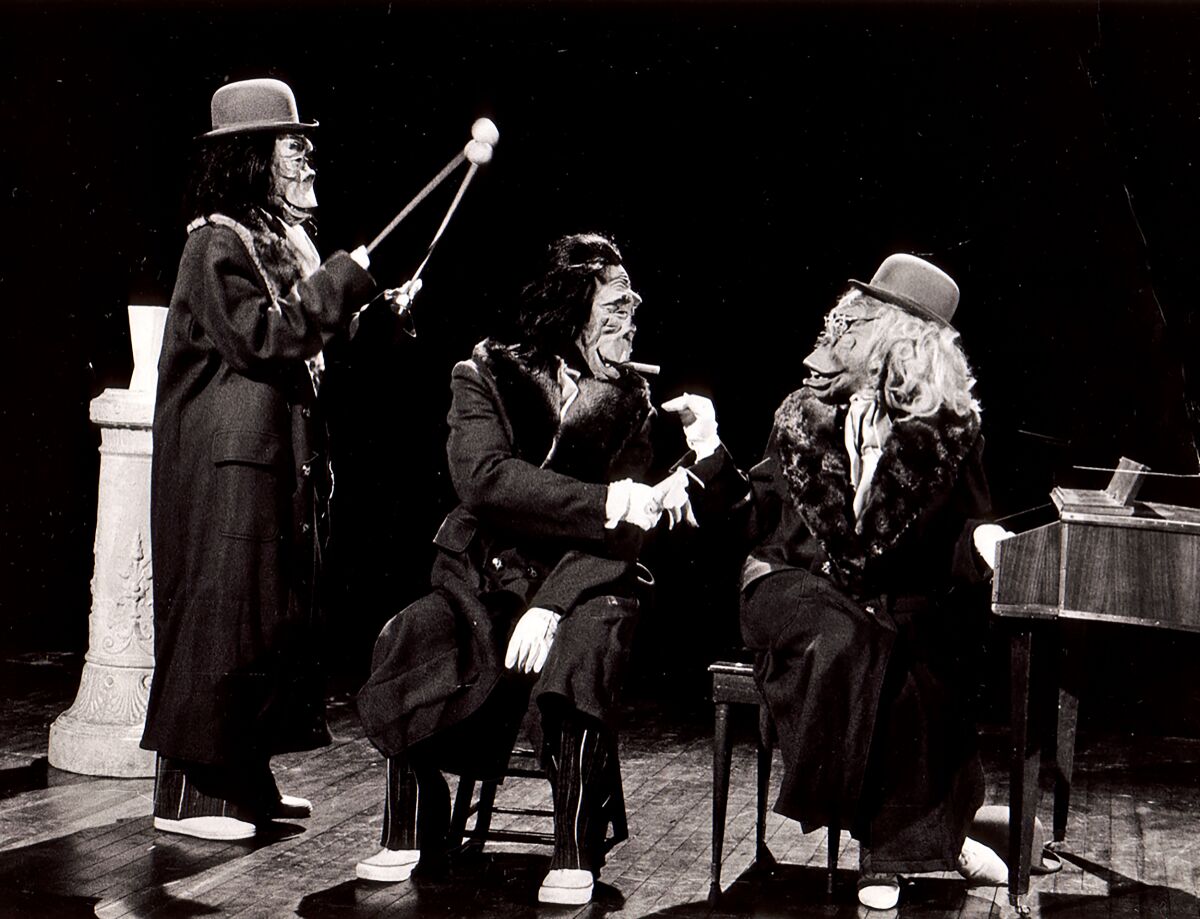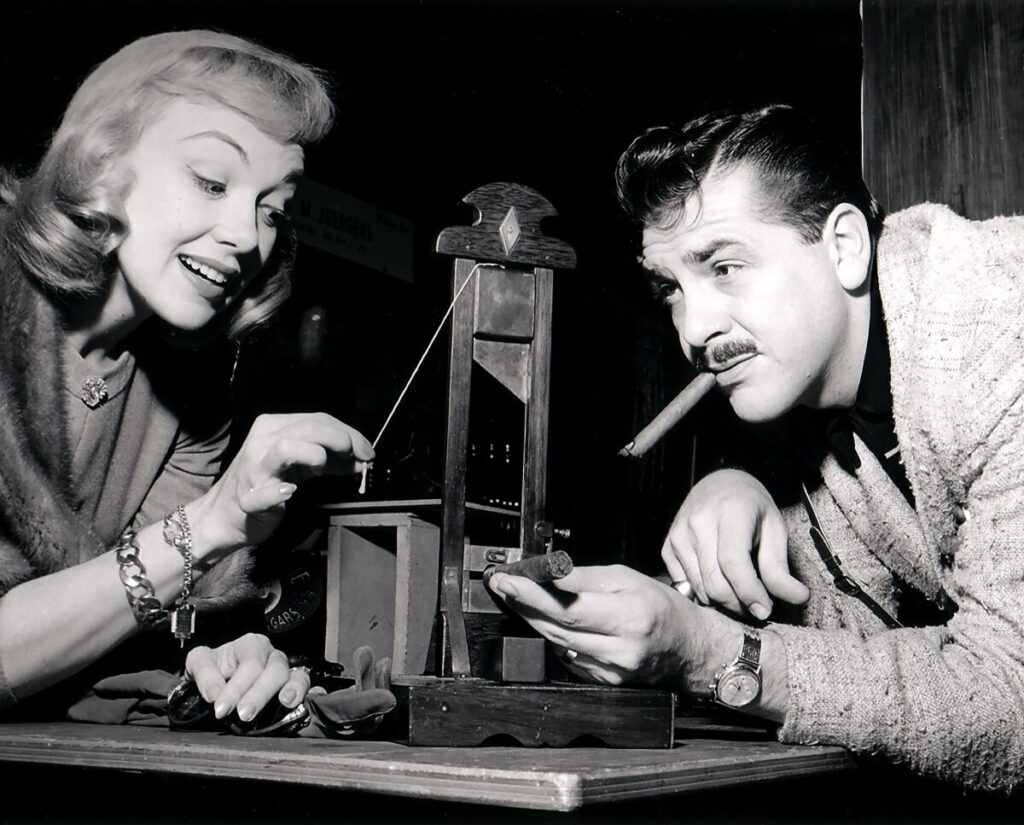As we bumble toward the end of the first quarter of the 21st century, it is safe to assume that a dwindling, if not already severely dwindled, number of Americans know the name Ernie Kovacs, madcap television visionary, let alone his work.
Many will know him only from film: “Our Man in Havana,” “Operation Mad Ball,” “Bell, Book and Candle,” comedies in which he played significant supporting roles, have been in steady rotation on local television and movie channels over the years. But TV was his medium, a medium he worked in and worked over — it was called a medium, he said, “because it is neither rare nor well done” — for 11 years, making it do tricks no one else would even think to try.
Three Kovacs specials, one from NBC from 1957 and two from ABC from 1961 — he had programs on every major network, including the short-lived DuMont — will screen Saturday as part of “Ernie Kovacs: Television of the Absurd,” a free program at the Billy Wilder Theater at the Hammer Museum in Westwood. Presented by the UCLA Library Film & Television Archive, the event is timed to the publication of “Ernie in Kovacsland: Writings, Drawings, and Photographs From Television’s Original Genius” (Fantagraphics), a thick, colorful scrapbook volume shepherded by Josh Mills, the son of Kovacs’ widow, co-star and archivist, Edie Adams. Mills, with co-author Pat Thomas, and actor-performer Ann Magnuson, whose “Kovacsland” essay cites him as a forerunner to the punk/art scene of 1980s New York, will speak. (As I wrote in a 2011 review of “The Ernie Kovacs Collection,” a six-disc DVD survey of his career, still available, “He was a video artist before artists got around to making video,” his deadpan visual punning a forerunner to works by the likes of William Wegman and Bruce Nauman.)
Edie Adams frequently collaborated with her husband, Ernie Kovacs.
(Ediad Productions)
To be sure, you may have chanced upon his work, which has occasionally been brought back to light, on PBS and basic cable, and examples of which might be discovered on YouTube — chance being the likely and also the best way to encounter it, to get the full “What am I seeing?” effect, so singular does it remain six decades after his death. (Kovacs died in a single-car automobile accident in 1962, an event that rated a banner headline in this paper and an on-air eulogy from Harry Reasoner.) You might have felt the same shock of the (old) new seeing “Monty Python’s Flying Circus” for the first time, when it sneaked into America by way of PBS, or discovering “SCTV” when it quietly arrived here by way of late night TV. Kovacs — an individual, an auteur, an outsider inside the system — also has something of the anarchic, world-upending, enrapturing appeal of Marx brothers and W.C. Fields, adopted as counterculture heroes long after their heyday.
“Ernie in Kovacsland,” which takes its title from an early series, will, of course, be of interest mainly to fans, or perhaps just fans of ephemera. It leaves out the sound and motion, naturally, but Kovacs was a writer as well, and the bits and pieces collected here give a good picture of the man, the personality and the artist. The volume reproduces personal and production photos, coffee-stained manuscripts, business letters, handwritten notes, published fiction and humor pieces and contemporary magazine articles by and about Kovacs.
There are movie posters and lobby cards; detailed plans for a record cabinet; three single-spaced typewritten pages correcting the facts in an upcoming magazine piece; and newspaper clippings that follow his progress from community theater to local to national television. A collection of guest essays, some highly informative, some merely personal, includes one by Ron Mael of the pop duo Sparks, on the Nairobi Trio — three “musicians” in ape masks, trench coats, wigs and bowler hats solemnly pantomiming, like automatons, to “Solfeggio,” a recurring piece that became Kovacs’ signature.

The Nairobi Trio, a signature segment of “The Ernie Kovacs Show.”
(Ediad Productions)
Along with an excerpt from Adams’ memoir, “Sing a Pretty Song,” the book includes a chunk of “Zoomar,” “a sophisticated novel about love and TV” Kovacs claimed to have written in 13 days; the draft of a piece called “Dreams of an Opus Eater” (“It was about 3:27 a.m., either Daylight Central, Daylight Saving or the other one peculiar to trains, just passing a Yucca tree, which if it was like most of the other Yucca trees, was about five feet tall, that I entered the permanent nebulous world of all night radio, disassembling cafe express makers, chronological sheep and snore balls”); a script for Kovacs’ “Kapusta Kid” sci-fi puppet show (and photographs of the puppets, which are raggedy and delightful); and the outline for a movie to star his silent character, Eugene.
Surreal and absurd, Kovacs’ humor forms the unsuspected link between Buñuel and Dali’s “Un Chien Andalou” and “Saturday Night Live” (whose Chevy Chase thanked Kovacs in a 1976 Emmys acceptance speech, 14 years after his passing). Sketches and blackouts are often evanescent, like an idea sketched on a cocktail napkin; some last only a few seconds yet might have been fiendishly complicated to prepare and execute. (Given the stagecraft and the pre-Gordardian manipulation of sound, it’s significant that Kovacs’ background was in radio and theater.)
Early in his TV career, there are skits and monologues and a set whose cartoonish background could easily have served for a children’s show (there were those puppets too). As he develops, across the 1950s and into the early 1960s, verbal comedy gives way to visual, until he’s making shows with no talk at all. (The NBC special being shown Saturday — in color! — is often referred to as “the silent show” and includes an eight-minute piece on the life of a drop of water.) His art moves toward a kind of conceptual purity, with deadpan visual puns (water bursts through a painting of a dam, a light drawn on a wall shines real light), manipulated video and real-time animations of household objects and office furniture choreographed to classical music. Smashed eggs, toy monkeys and a broken celery stalk “perform” the “1812 Overture.”
Even in the long history of television, with its multiplying multiplicity of channels and platforms, there have been relatively few programs that could be said to be experimental, to play with form as a kind of content, to pull the medium apart and put it back together in a brand new shape. I think of the meta-sitcom “It’s Garry Shandling’s Show” (on which Adams twice was a guest); John Lurie‘s “Painting With John”; Terence Nance’s “Random Acts of Flyness”; Tim Heidecker and Eric Wareheim‘s “Tim and Eric Awesome Show, Great Job!”; Adult Swim’s 4 a.m. “Infomercials” block, whose best installments, like the endlessly cycling, morphing faux-sitcom title segment “Too Many Cooks,” are not literally indescribable but do take effort to put into words. And then I have to think a lot harder.
But Kovacs’ influence was more widespread, more subtle. Like Mad magazine, another purveyor that was both widely celebrated and utterly subversive, and for which Kovacs sometimes wrote, his legacy exists in generations of weirdos who, if not following exactly in his footsteps, having seen his stuff were never quite the same and found new ways, new forms, new content, new mediums in which to express their otherness.

